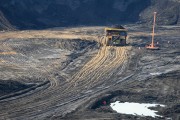I start my mornings with a cup of coffee and a quick scan of the headlines to see what's at play in the world of energy and the environment. Hey, it's my job. Like me, you probably saw the oilsands headlines again this week, spurred on by a quip from former American Vice President Al Gore. He said, "Gas from the tar sands gives a Prius the same carbon footprint as a Hummer."
Not surprisingly, the Alberta government has responded in-kind: Premier Stelmach called Gore's assertions "preposterous" and labeled greenhouse gas pollution from coal-fired electricity, both in the United States and in Alberta, as "the elephant in the room." And David Sands, the Public Affairs Bureau's chief defender of Alberta's oilsands in the blogosphere and on Twitter, quickly called Gore out on the math behind his Prius vs. Hummer sound bite.
 While the government concludes the impact isn't as bad as going from a Prius to a Hummer, their math still shows that the oilsands are worse. If the best result that can be mustered is "worse, but less worse than critics suggest," we have a problem. It really is an uphill battle for Alberta to suggest this response is good enough when scientists are telling us we must do much more to reduce greenhouse gas pollution to avoid the worst impacts of global warming.
While the government concludes the impact isn't as bad as going from a Prius to a Hummer, their math still shows that the oilsands are worse. If the best result that can be mustered is "worse, but less worse than critics suggest," we have a problem. It really is an uphill battle for Alberta to suggest this response is good enough when scientists are telling us we must do much more to reduce greenhouse gas pollution to avoid the worst impacts of global warming.
The crux of the issue is that the Alberta government's approach to addressing greenhouse gas pollution is focused on modest improvements in pollution intensity. We have more than a decade of evidence of just how ineffective improvements in emission intensity are in the face of rapidly expanding oilsands production. Between 1990 and 2006 total greenhouse gas pollution from the oilsands sector increased more than 200%, while over the same period Suncor reduced the emissions intensity of its oil sands operations by approximately 45%.
As a result, Environment Canada has projected that with business as usual the oilsands would be responsible for almost half of all new greenhouse gas pollution in Canada by 2020.
But looking to the future, I'm afraid there's more bad news for the oilsands: the average greenhouse gas intensity of producing a barrel of oilsands is likely to get worse. About 80% of oilsands reserves are only accessible using in situ drilling technologies. This type of oilsands production is more energy intensive than the surface mining operations, which means that the corresponding greenhouse gas pollution emitted to produce a barrel of oil is also higher. This would be made even worse by a draft Alberta government policy that would allow in situ oilsands operations to burn even dirtier fuels than the natural gas they consume today.
Despite the promise of carbon capture and storage technology, including $2 billion in Alberta taxpayer subsidies, there is nobody in the oilsands industry who is seriously considering applying this technology to in situ oilsands operations anytime soon. A number of the companies who were considering it abandoned plans and withdrew from the competition for public subsidies in light of the economic challenges. That's right, we couldn't even pay them to try it.
So while Al Gore's math might be off, I think the symbolism of his quote is dead on: the oilsands are a dirtier source of fuel. What we need are cleaner sources of fuel.
This is an inconvenient truth that the Alberta government remains stubbornly unwilling to acknowledge let alone meaningfully address. Unless and until the Alberta government comes around on this then we face both an environmental and economic problem.
The rest of the world is moving towards a low-carbon economy and we risk being left behind.









